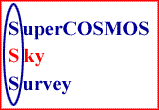
|
| SuperCOSMOS |
| Sky Surveys (SSS) |

|
|
Introduction to extracting catalogues
Given a free format
RA & Dec (eg 01 10 34.2 -65 32 07), equinox (B1950 or J2000),
the size of a rectangular or circular region to extract, the primary
waveband/Schmidt survey required and a magnitude range the web-form,
Get a Catalogue, returns a listing of the
objects detected by SuperCOSMOS during its Image Analysis Mode (IAM).
Most of the object parameters returned are derived from the
measurement of the plate in the primary waveband selected on the form.
Magnitudes in the other secondary wavebands and proper motions are
also returned where available.
The extraction software works across plate/field boundaries and
therefore large areas can be searched (up to 100 sq degrees).
The user can specify the output equinox, the output epoch and the format
(ASCII, Tab, FITS) of the data returned. The tab-separated listing is
compatible with the GAIA
and CURSA software packages and is useful if you want to overlay the extracted objects
on, for example, a radio pixel map (assuming the pixel data comes with
a built in World Coordinate System).
Expert parameters are also available on the form. The default values
will provide the user with a sensible catalogue that contains a minimum
amount of spurious sources (for example areas around bright stars are
excluded to prevent contamination from diffraction spikes and haloes).
For the form to successfully return data covering the entire region
requested the relevant survey plate(s) must have
been measured and put on-line. Some plates have not yet be taken and/or
scanned. A summary of scans available on-line can be found
under sky coverage.
Home |
Intro |
Get an Image |
Get a
Catalogue
Coverage |
Documentation |
History |
Links
WFAU, Institute for Astronomy,
Royal Observatory, Blackford Hill
Edinburgh, EH9 3HJ, UK
M.Read@roe.ac.uk
30/7/2008
|

